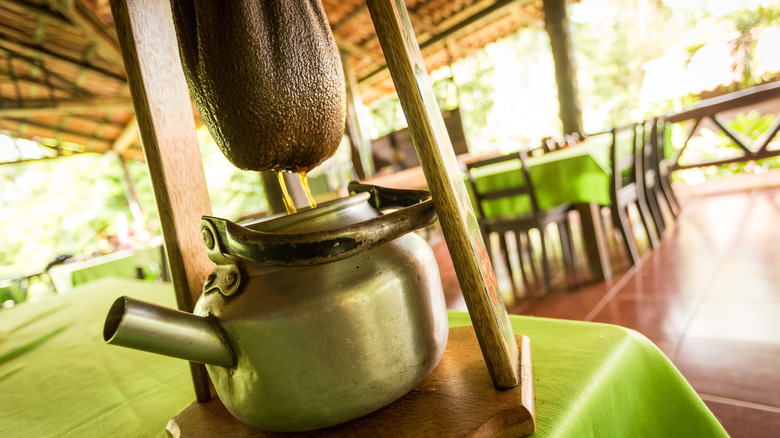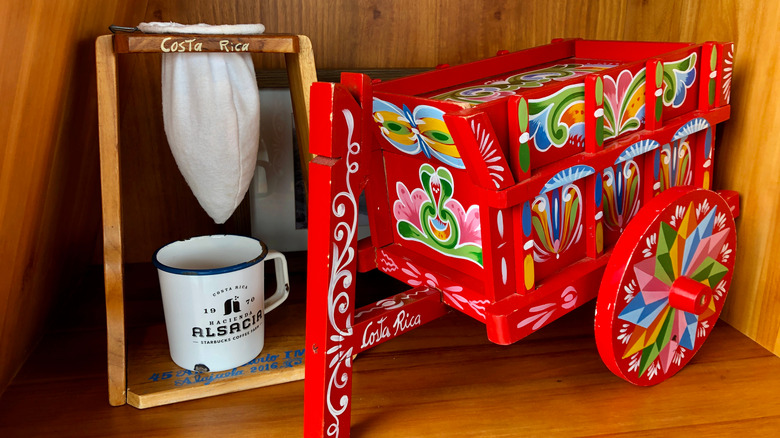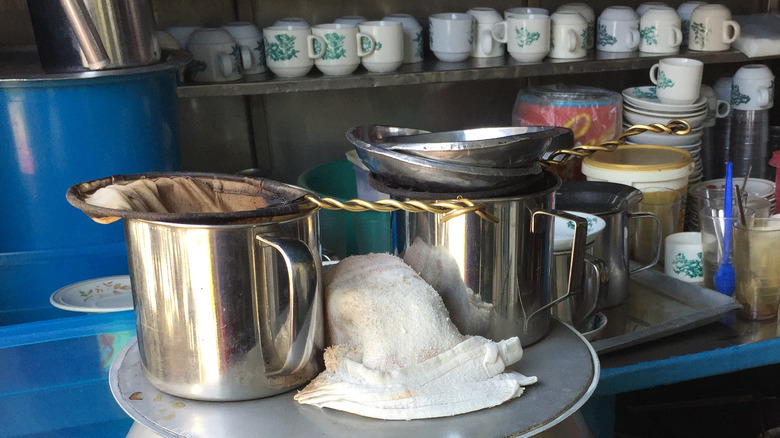Does The 'Sock Coffee' Brewing Method Actually Involve A Sock?
As far as Ethiopians are concerned, the world has a man named Kaldi (and his goats) to thank for discovering the brew that powers our mornings. Kaldi is said to have found his goats in a particularly hyperactive mood after munching on the red berries from a mysterious shrub, and when he tried the berries himself, the same thing happened to him, as did a monk who gave the berries a try, per PBS.
But coffee — as we enjoy it today — didn't make an appearance until the 13th century and by this time, History Cooperative says preparing coffee meant soaking grounds for anywhere from five hours to half a day in hot water. This way of making coffee, which is known as the Ibrik Method, involves mixing water, grounds, sugar, and spices in a cup, then heating and cooling coffee and water in a small pot several times until the beverage is ready to drink. Tedious as that may sound, the method is still being practiced in Turkey.
When coffee made its way to Europe, it was brewed by pouring grounds into a coffee pot, adding water until it was just about to boil, then pouring the coffee out into cups. The grounds weren't filtered in any particular way, instead, they got stuck in the spout as the coffee was being poured out. Luckily, innovations were made to prevent this.
Costa Rica's chorreador may have been the first sock coffee
Given that a coffee pot spout couldn't catch all the coffee grounds as the beverage was being poured out, History Cooperative explains that some historians posit that socks may have been used as the first coffee filters. While WOBH Filters says these early cloth filters were popular because they kept the grounds out of the coffee, History Cooperative also says these rudimentary coffee filters weren't very good because they didn't drain the coffee properly, which is how metal filters and contraptions known as Biggin pots, which make use of a filter placed under a lid, came to be invented.
The original "sock coffee" could well have been Costa Rica's chorreador, which was invented more than two centuries ago, and is still in use today. The chorreador consists of a wooden stand and a sock, whose mouth is kept wide open by a piece of wire. Ground beans are then placed in the bag before hot water is poured over them, per Cafe Britt. These cloth socks can be rinsed out after use, but never washed with soap, and they can be used for up to three years if maintained properly. The same brewing principle applies when you use a sock filter, which normally comes as a "long cotton bag on a handle," and is used around the world, per Pour Over Project.
Sock coffee can be found around the world
Costa Rica isn't the only place where the long cotton cloth "sock" filter is still used to make coffee today. Sock filters are also used in other countries in Central America like Cuba and further north in Mexico. But "sock coffee" is also made in Asia, in countries including Singapore, Malaysia, Thailand, and Indonesia, per Coffee Detective, which posits that the idea of using a repurposed old sock to make coffee could have inspired a few folks at the same time.
It's not that espresso can't be found in these countries, particularly in Southeast Asia, which has thriving modern coffee cultures and a heavy Starbucks presence. But as Pour Over Project points out, most of the coffee beans that are grown in Southeast Asia are of the Robusta variety, and this type of bean — which a higher caffeine content and which yields a stronger, more bitter coffee — does better when it is prepared using a sock filter.


